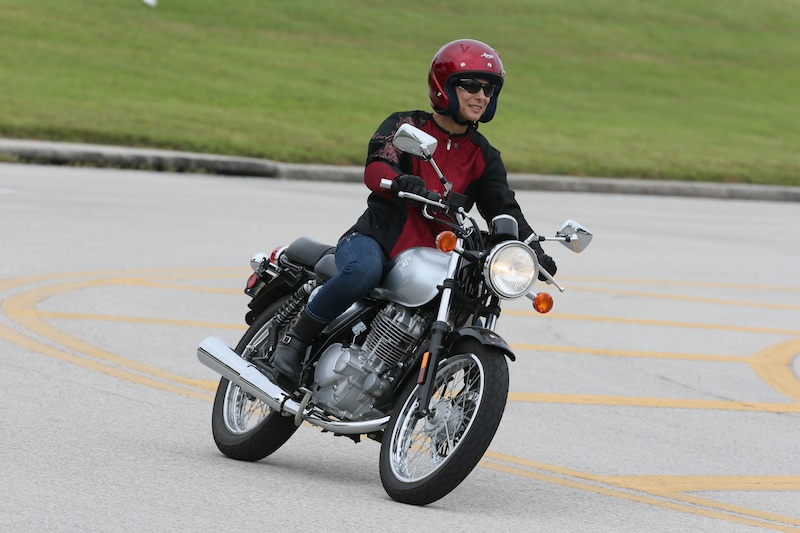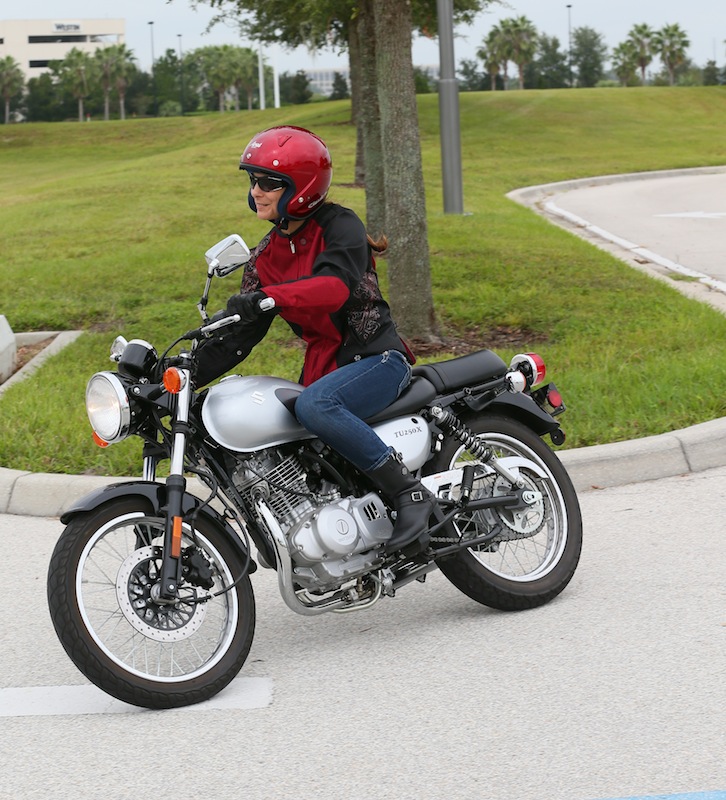There’s only one aspect of riding a motorcycle properly where your instinct is actually correct, well semi-instinctual, and that’s counter steering. Before I go any further I’ll define what’s commonly known as counter steering.
I actually prefer the term “push steering” since it’s a lot less confusing.What push steering/counter steering means is in order to change direction at speeds above 15 mph, like when rounding a curve you must push forward on one of the grips.To go left, you push forward on the left grip; the motorcycle leans left and goes left.To go right, you push forward on the right grip; the motorcycle leans right and goes right.Under normal conditions, the majority of riders have no problem push steering/counter steering even though most riders don’t even realize they’re doing it. If you’ve ever rounded a curve at speeds above 15 mph on your motorcycle, you’ve push steered/counter steered.

So, why do I say push steering/counter steering is only semi-instinctual? Because if you have to push steer/counter steer in a hurry, as in an emergency situation, chances are you will do the opposite.Here’s the scenario: You’re cruising down the left lane passing a vehicle in the right lane.The driver in the right lane starts to drift into your lane.About half of you will attempt to turn your handlebars to the left, away from that vehicle.That is mainly due to being used to driving a four-wheeled vehicle and it works great in a four-wheeled vehicle.However, on the two-wheeled vehicle, that quick defensive turn to the left amounts to a push forward on the right grip.That of course will cause the bike to lean right and go directly into that vehicle.
Here’s another scenario.You’re speeding straight down the highway when a vehicle pulls out from your right in an attempt to cross the highway and your path of travel. You try to steer to the right to get around the back of that vehicle, that quick reflexive turn of the bars to the right causes the bike instead to lean left and go left directly into the vehicle you were trying to avoid.
I’m aware that many of you riding motorcycles for years don’t believe a word I’ve just written.If you’re one of those riders that doesn’t believe me or, doesnt understand the push steering/counter steering phenomenon, here’s an easy way to prove to yourself how it works.Get on your motorcycle, and ride above 15 mph and give a little push forward on one of the grips.I’ll wait right here while you try it.OK, you’re back.Now that you understand how it works and that I’m not feeding you a line of bull! Let me show you how to use push steering/counter steering to your advantage all the time, even in an emergency situation.
Find a deserted road or a parking lot with enough space to get to 15 mph or above. (By the way, the reason you can’t push steer/counter steer below 15 mph is that the gyroscopic effect of the two spinning wheels of the motorcycle is not strong enough to overcome the force of gravity wanting to pull you down to the ground.) Now all you have to do is push forward on the right grip, then the left grip and feel the bike lean and swerve from side to side.Next, set up five or six cones or any kind of markers you have at 30 feet apart and weave through them at 20 mph. Practice this until you avoid all the cones without slowing down or using any braking.

To see how push steering/counter steering can help you on a winding road, start turning some big circles. When I say big, I mean at least 50 feet in diameter. The bigger the circle, the higher the speed you can obtain.As you’re circling, notice that if you push forward on the low side grip, the bike will lean further to the low side and the circle will tighten up the harder you push forward on that grip.At these counter steering speeds, it’s helpful to lean your body slightly toward the low side as well. Just make sure your head is level with the horizon.
You may have seen racers leaning so far off the low side of their bike that they can even drag a knee on the ground.While I don’t suggest you go anywhere near the “hanging-a-knee-off” extreme, you will discover how much faster you can round a curve using this technique.Make sure you practice in both directions. The more you practice these simple exercises, the sooner push steering/counter steering will truly become instinct all the time.

About the Author
Jerry Palladino is the founder of Ride Like A Pro, Inc., a company that produces motorcycle instructional DVDs and books. Jerry is a former motorcycle police officer who teaches riders the same skills that that motor officers use when riding their motorcycles. His classes are aimed at experienced riders who want to enhance their motorcycle skills. VisitRideLikeAPro.com.

Related Articles

Thank y’all for sharing this info. I have been riding since I was 14—off and on during this time. I am 69 years old now. I am going to order these DVDs. Y’all ride safe.
I have found that if you are riding a large cruiser bike, where you are mostly sitting straight up or the body is normally leaning back, it is very helpful to lean your body forward (like riding a sportbike) during a push turn. It helps put that extra ‘push’ on the handlebars during the turn.
Great article! I wondered about steering that way and after reading the article, it all made sense. Now to get clever on my cruiser.
I spent 15 years on Yamaha Viragos (cruisers) and them moved to a BMW R 1200 RT (sport tourer). The difference in countersteering the two different bike types is amazing. The sport tourer responds almost immediately, and you are further into a turn/move, than the cruiser. It took some time to “trust” myself on the new scoot. I was expecting a change, but I never expected it to be so dramatic!
Awesome article. I’ve been riding for about a year and a half. Me being a typical girl on a sportbike, I get all the comments of people saying it’s too big for me, or girls shouldn’t ride. But I must say, getting a bike is the best thing that has ever happened to me, and I definitely paid attention in the safety class I took to get my endorsement because riding means so much. The way you described counter steering is exactly how I was taught how to ride. I don’t know how to ride any other way. I’ve had plenty of close calls in my short time of riding, and counter steering has definitely been a savior. It really is a good technique to know, regardless of what kind of bike you’re riding. Ride safe, friends!
Great article! When I first was instructed on this steering method, I was skeptical about it, but after road-testing it, I found that it made my ride much easier and more relaxed. I had really been over-driving my bike. Likely due to apprehension, but after learning this technique, I loosened my grip and finally unclenched my jaw. Now I love the curves!
Very informative. Thanks for the tip
As a former Police 911 Communications Officer/Dispatcher, I agree with everything said in the above story. I would, however, give caution to your lean-speed when gravel on the roads in a curve might be a factor. Gravel at any lean-speed can tip the balance in seconds. Also, if you carry a rider two-up, let him or her know to not lean beyond your lean. Let that person know to follow you and the bike when in a lean-speed. Often a newbie second-seat rider will want to see everything you see and will lean heavy to the side in an attempt to see past you. When in a lean-speed curve it lays the balance and the driver has to comp for that. I have heard countless stories about two-up lean-speed curves. Anyway, this story is a wonderful reminder to old-hat riders and a must to any newbie. The art of counter-steering or lean-steering is a must to master. Of all the tips and tricks in your riding inventory of skills the counter-steering skill is the one that is most likely going to save your life one day. Yes, agreed, it is that important!